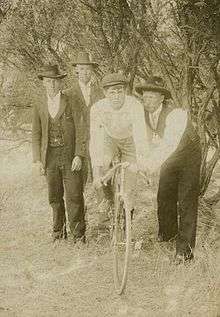Mulga Bill's Bicycle
| Wikisource has original text related to this article: |

"Mulga Bill's Bicycle" is a poem written in 1896 by Banjo Paterson. It was originally published in the 25 July 1896 edition of the Sydney Mail, and later appeared in the poet's second poetry collection Rio Grande's Last Race and Other Verses.
The poem is a ballad.[1] Each line is a fourteener, having fourteen syllables and seven iambic feet.
It tells the tragic tale of Mulga Bill, a man whose pride in his riding skill causes him to purchase, ride and crash a bicycle. Although Mulga Bill claims expertise in riding all things his ineptitude and subsequent accident suggest that he may only know how to ride a horse.
The poem was first published in The Sydney Mail on 25 July 1896.[2] It is amongst Paterson's most popular works.[3] A 1973 reprinting of the poem illustrated by Kilmeny & Deborah Niland has been continuously in print since publication and won the 1973 ABPA Book Design Award and the 1974 Visual Arts Board Award.[4]
The novel by H. G. Wells on cycling, The Wheels of Chance: A Bicycling Idyll was published in the same year as this poem.[5]
The poem actually featured the Safety bicycle. However, the poem has been inaccurately illustrated by various illustrators with a depiction of the visually more interesting Penny-farthing which had been superseded at the time the poem was written.[6][7] The introduction of safety cycles gave rise to a bicycling boom with millions being manufactured in the decade 1890-1900. They were very popular in the Australian outback, widely used by shearers and itinerant workers at the time that Paterson wrote this poem.[6]
The model for the character of Mulga Bill was William Henry Lewis (1880-1968), who knew Paterson in the vicinity of Bourke, New South Wales. Lewis had bought his bicycle as a result of a drought when there was no feed for horses.[7]
Eaglehawk, Victoria—once a rural mining town, now part of greater Bendigo—was given as Mulga Bill's hometown ('Twas Mulga Bill, from Eaglehawk ...). This has been recognised with the development of the Mulga Bill Bicycle Trail, a scenic ride taking in many of the mining attractions, historic sites and modern-day amenities of Eaglehawk.[8]
Mulga is a very common species of Acacia that predominates the interior regions of the Australian bush, and colloquially, it is an alternative term for the Bush itself or wilderness regions, for example ‘up the mulga’.[9]
The poem has been set to music [10][11] and the poem title was the name of a prominent Australian folk music group (also known as a bush band) in the 1970s.[12]
References
- ↑ "What is Poetry (Ballad)" (Shockwave; click on the link for Ballad). Aussie SchoolHouse - Teachers on the Web. Australian Council for Computers in Education (ACCE). Retrieved 2008-09-30.
- ↑ "Mulga Bill's Bicycle by A.B. "Banjo" Paterson". Perry Middlemiss.
- ↑ Densley, Kevin. "Collected Poems by Banjo Paterson ISBN 978-0-207-19867-0 Teacher's Notes Prepared By Kevin Densley" (PDF). Teachers' Guides. HarperCollins Publishers (Australia). Retrieved 2008-09-30.
- ↑ "Mulga Bill's Bicycle". Deborah Niland: artist and illustrator. Deborah Niland. Retrieved 2008-09-30. Published by HarperCollins, Australia, April 2007 New edition, ISBN 978-0-207-17284-7. First published by William Collins Australia Pty Ltd HB 1973, PB 1976.
- ↑ Lloyd, Rosemary (April 2005). "Reinventing Pegasus: Bicycles and the Fin-de-Siècle imagination" (pdf). Journal of the Society of Dix-Neuviémistes (4): 55. ISSN 1478-7318. Retrieved 2008-09-29..
- 1 2 Fitzpatrick, Jim (1980). The Bicycle and the Bush: Man and Machine in Rural Australia. Melbourne, Australia: Oxford University Press. pp. 24, 234–236. ISBN 0-19-554231-2.
- 1 2 "Mulga Bill rides again" (PDF). Push on. Volume. Bicycle NSW. 31 (11): 8. November 2007. Archived from the original (pdf of 16 pages) on 2008-07-21. Retrieved 2008-09-29..
- ↑ "Mulga Bill Bicycle Trail". Bendigo Tourism. Retrieved 2008-09-29.
- ↑ Wilson, Pip (2007). Faces in the Street: Louisa and Henry Lawson and the Castlereagh Street Push (pdf, 585 pages). Pip Wilson / www.boilingbilly.com. p. 523. ISBN 978-0-9803487-0-5.
- ↑ Patton, E.A. & Paterson, A.B. & Australia Music Centre. 19--, Mulga Bill's bicycle [music]: for choir (sopranos, altos, baritones) pianoforte (four hands), flute, clarinet, trumpet, violin, cello, percussion - found in NLA catalogue.
- ↑ Peachey, Andrew. & Paterson, A.B. & Australian Music Centre. 1999, Mulga Bill's bicycle [music]: for SATB choir & piano / text by A.B. ("Banjo") Paterson; music by Andrew Peachey.
- ↑ Folkloric recording. Chris Bettle speaks about joining the prominent folk band Mulga Bill's Bicycle Band (MBBB) in 1972; touring Australia wide for two years; the songs they were singing; in Bettle, Chris, & Willis, Rob, 2008, Chris Bettle interviewed by Rob Willis in the Rob Willis folklore collection [sound recording] (at National Library of Australia).